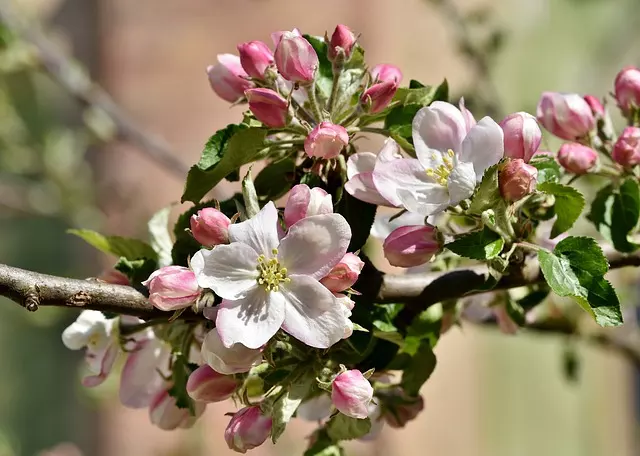Recently our gardening readers wrote to us with some questions and sent us some photos. Among the questions received, our readers ask us, “When to prune apple trees in Michigan?” “Is the season starting? Is it true that there is summer pruning and winter pruning for apple trees?” “Can you add a diagram to know which branches to prune from the apple tree?” At the request of our readers, we have updated this article, adding a few Prune Apple Tree Diagrams, and we appreciate the photos sent from your gardens. Also, we recently added how to prune an apple tree with pictures. I encourage you to read this article to the end and also watch the video on how to prune apple trees to encourage apple production.
We know that gardening is not as simple as it seems, and apple pruning follows the same path, but here’s when to prune apple trees for good fruiting, and let’s see about pruning with valuable diagrams.
Pruning an apple tree is a task that not everyone does correctly; it is an activity that combines technical knowledge with logic.
Table of Contents
VIDEO: How to Prune Apple Trees VIDEO
VIDEO: How to Prune Apple Trees. This is an excellent video with experts showing how and when to prune apple trees.
Why Do We Prune Our Apple Trees?
Pruning is the removal of some parts of the tree for a particular purpose. This practice must be carried out according to specific rules and with the proper tools.
The reasons for pruning are listed below:
- To promote good fruit production.
- To give the plant a proper shape that will permit it to give the plant a proper shape that allows it to be used.
- To maintain good tree health.
- In the case of fruit trees, to improve fruit quality.
- To limit plant growth.
- To attenuate alternations in production.
- To maintain a balanced shape in our apple trees.
Why Is Apple Tree Pruning So Important? What Happens If I Don’t Do It or Do It Wrong?
- Pruning apple trees is essential for two main reasons:
- To help maintain balance: to control the vegetation of the plant.
- To improve fruiting: It helps us to have more and better-quality fruit.
- The purpose of pruning the apple tree is to have more giant apples. If the fruit tree is not pruned, it will have more flowers and less fruit.
- If an apple tree is not pruned, it will flower a lot because it has a lot of vegetative buds, and it will impede the fruit budding.
When Prune Apple Trees
To know when to prune apple trees, you have to take into account the season you are in. Within the pruning of apples or pear trees, there are two types of pruning depending on the time of year:
On the one hand, winter pruning is also known as straight pruning or dormant period pruning. On the other hand, summer pruning or green pruning is done during the rest of the year.
The main pruning is winter pruning, followed by one or two more prunings in summer.
Prune Apple Tree Diagram – The Right Tools for Pruning an Apple Tree
Before pruning the branches of your apple tree, it is important to choose the right material for pruning, as a bad choice can make your tree sick:
Prune Apple Tree Diagram – Let’s see the Right Tools for Pruning an Apple Tree
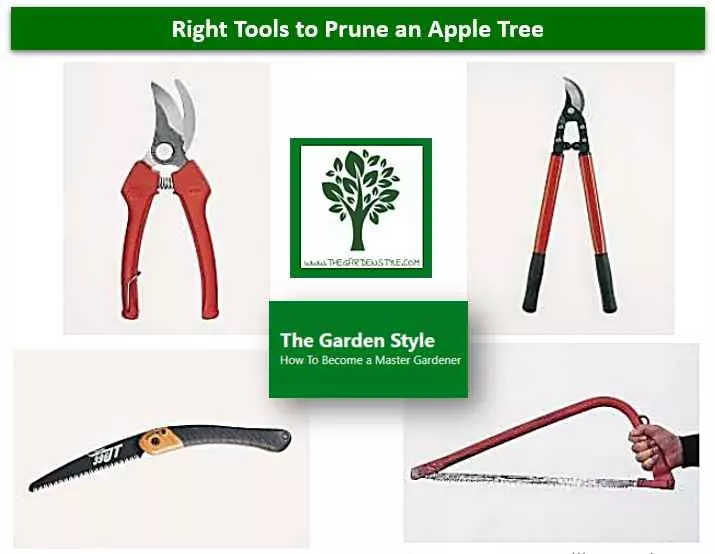
Apple Tree Pruning Material
Pruning Tool
- An item such as a knife or razor will help you prune your tree with horizontal cuts. A pruning knife is ideal for apple tree pruning.
- Don’t forget always to disinfect your tools before pruning.
- Also, remember that it must be sharp enough to make clean cuts with a certain inclination.
Pruning Sealer for Apple Tree
- This type of dough is used to seal the cut branches and prevent future infections or diseases.
- It would be best if you got a pruning sealer in any specialized store or, failing that, you can make it at home.
- If you do not want to make the homemade pruning sealer, you should buy the same one we use in our plants.
- Use to seal wounds and grafts
- Helps repair damage caused by pruning, animals, insects, storms, and string trimmers
- Provides flexible protective seal
When to Prune Pome Fruit Trees (pear, apple, quince, etc.)
The pruning of pome fruit trees, such as apple trees, should always be done during the vegetative rest period when the trees have already lost all their leaves. The ideal time is usually around December-January, varying according to the area. It is also necessary to be careful with the danger of frost in the days following pruning.
When to Prune an Apple Tree: Pruning Time
Apple tree pruning should always be done in winter when the leaves have fallen.
Prune Apple Tree In Summer
Apple tree pruning in summer, although technically it is spring, can be done as “green” pruning.
In April, excessively numerous shoots can be removed, and in August, branches of more than 30 cm, with 5 leaves, can be pruned to favor flowering buds.
Prune Apple Tree In Winter
Winter pruning of apple trees begins towards the end of summer, in autumn, punctually, as soon as the last leaves fall, until the end of winter when the buds are still resting (November, December, January, and February).
How To Prune An Apple Tree Diagram
Let’s see with these diagrams How To Prune An Apple Tree
How To Make the Perfect Cut?
Let’s see this Prune Apple Tree Diagram
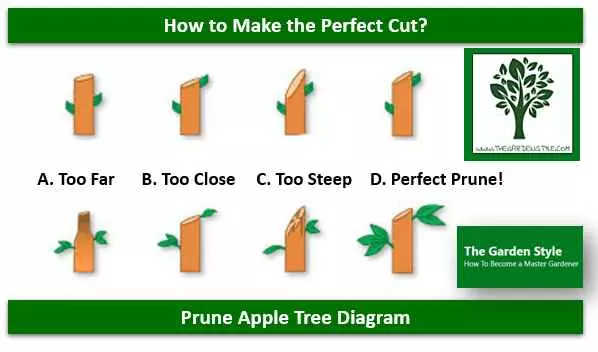
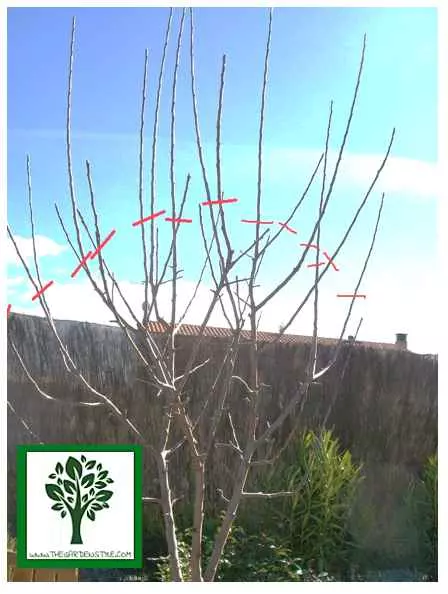
How To Prune An Apple Tree with Pictures
What to Consider When Pruning an Apple Tree In Winter
- Pruning should favor the entry of light and air throughout the canopy, leaving only the guide branches necessary to maintain the structure. The recommended shape is that of a “cup or inverted umbrella”, without a central axis.
- Fruit plants should have a balance between the flowering part (which will eventually bear fruit) and the vegetative part (leaves).
- Old branches and “suckers” should be eliminated, which are long, vigorous branches, not very woody, and with few buds that generally grow next to a cutting or on the sides of thick branches or from the base.
- Form a canopy that is not too high to allow adequate fruit harvesting. For this purpose, thick branches that have grown tall can be cut, and/or the more flexible branches can be bent to slow sap circulation and generate more flower buds.
- Do not allow tight angles between branches (ideally more than 45º)
- New branches developing on either side of thicker branches should not be too close together (6 inches – 15 cm – or more apart).
- In pome fruit trees, prune short (one-third or less than half the length) the branches of the year. In stone, fruit trees prune long (more than half the length), with the same branches.
- Prune flush the branches of the year and others, poorly oriented (downward or inward of the crown).
- In apple trees, branches are pruned annually, leaving them short so that they accumulate reserves at the base and generate thickened buds, which are the ones that will bear fruit. Other branches can be pruned if this helps to improve the shape of the canopy. Branches three or more years old are also pruned to favor fruiting buds in the basal zone, but if they are more than 1 inch (2 cm) thick, they are pruned long. In these fruit trees, fruit formation is repeated at the same points, so pruning should be directed to new branches that develop flower buds near the basal part.
- As a general rule, the most vigorous branches of the year (containing more reserves), as in the case of apple, pear, and cherry trees, are pruned short. The branches of the less vigorous year (few reserves) are pruned long, as in the case of plum, sour cherry, and quince.
- If the plant has branches more than two years old, i.e., of a certain thickness, which are well oriented, they are pruned long (stone and pome).
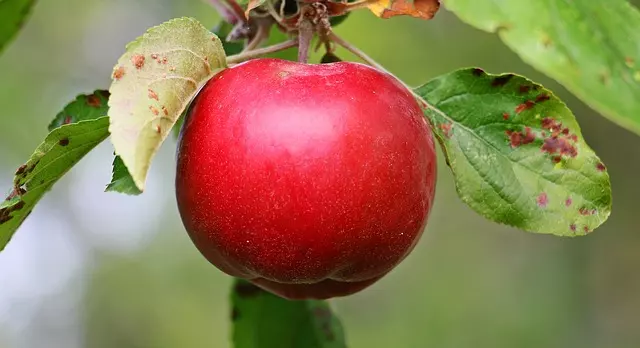
I encourage you to continue reading this article about the Prune Apple Tree Diagrams – How & When to Prune Apple Trees to get out of the most of your apple crop.
Types of Apple Tree Pruning – Prune Apple Tree Diagram
To know what type of pruning your tree needs, you must study its needs. Normally, depending on the age of your apple tree, one type of pruning or another will suit it.
Pruning fruit trees is not the same as pruning other species. Remember that the objective of pruning is to obtain large, quality fruit.
The objective is clear: to have a directed growth where branches do not cross each other.
It is important that, if you have never pruned an apple tree, you do not prune it completely the first time you do it. It is more advisable to do partial pruning. Let’s see this Prune Apple Tree Diagram.
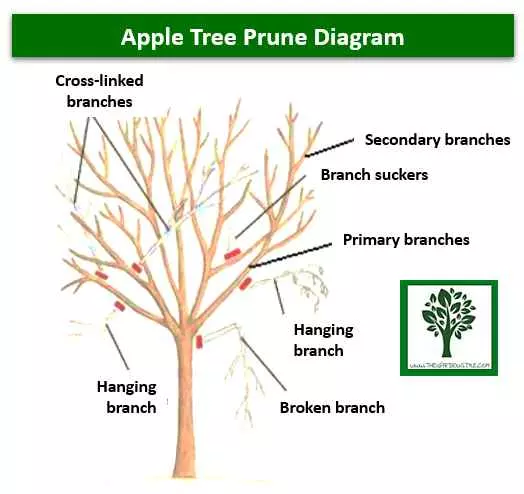
The aim is to achieve a structure of branches that grow horizontally; for this, we have different types of pruning:
- Training pruning: this type of pruning is recommended until the apple tree reaches 4 years of age.
- Cleaning pruning: the generic pruning par excellence. In this pruning, it is necessary to remove dry branches or those that damage the rest of the tree, and it is done every year.
- Fruiting pruning: this type of pruning for apple trees seeks to renew the shape of the tree to prepare it for the next harvest.
- Regeneration pruning: in cases where apple production is decreasing, this type of pruning is recommended to produce a regrowth in the fruit tree.
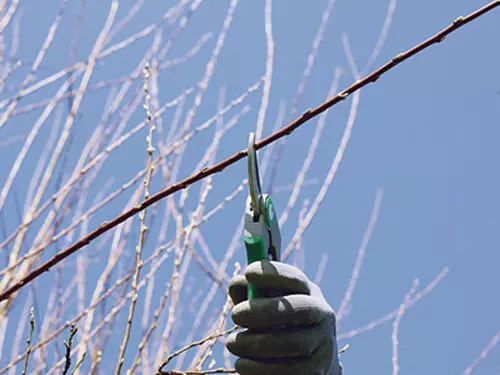
Pruning Apple Trees: Knowing What to Cut
To know how to prune a fruit tree correctly, you need to know how to identify what you want to remove correctly.
Apple Tree Pruning – Before And After Diagram
Let’s see this Prune Apple Tree Diagram
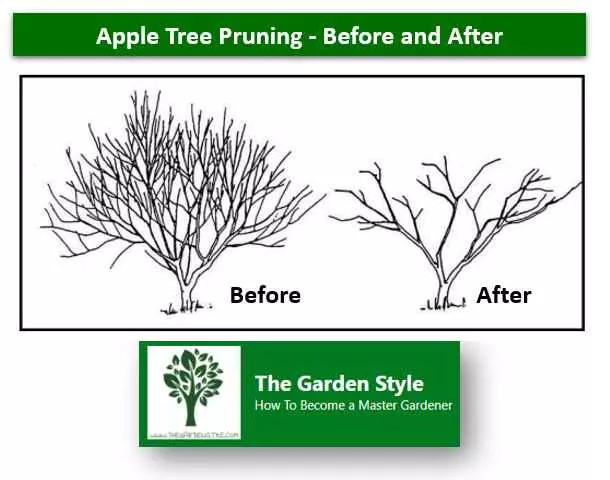
Knowing the structure of the branches is very important to prune an apple tree correctly, so here is a brief explanation of the types of apple tree branches to prune:
Apple Tree Bud
When pruning apple trees, the aim is to find a balance to achieve a good production in volume and density in both the blossom buds and the wood buds.
The blossom buds are those branches with a pointed tip on which the blossom of the fruit tree will sprout.
Vegetative buds (also known as male or wood buds) are smaller in size and provide vegetation. This type of branch should be kept if we want to increase production.
If we have a lot of small apples, we could remove part of these buds.
I invite you to read on about Prune Apple Tree Diagrams – How & When to Prune Apple Trees to get the most out of your apple harvest.
Homemade Pruning Sealer for Your Apple Tree
Many gardeners are not fond of using chemicals and artificial fertilizers for their gardens. That’s why we recommend this homemade pruning sealer to seal the branches of your apple tree. We will need:
- A container for the mixture.
- Plasticine: It serves as a waterproofing agent. Choose a neutral color to avoid the attention of insects.
- Olivia oil: to better seal the paste.
- Ground cinnamon: it is an excellent fungicide. It prevents the appearance of fungi.
When you make a mixture with consistency, it can be spread on the surface of the branch without a problem.
Steps to Prune Apple Tree – Prune Apple Tree Diagram
Now that you know everything there is to know about apple tree pruning and fruit tree pruning, we tell you what steps you need to follow to prune apples correctly:
- Identify dead, broken, or diseased branches that cannot be recovered.
- Cut those canes inside that cross or generate shade in the case of an adult apple tree.
- In the case of wood buds, try not to eliminate them, only reduce their size; cut this type of branch with the bud towards the outside.
- Seal each cut with a pruning sealer to avoid infections in the next sprouting.
Prune an Apple Tree with Pictures
Let’s see this Prune Apple Tree Diagram
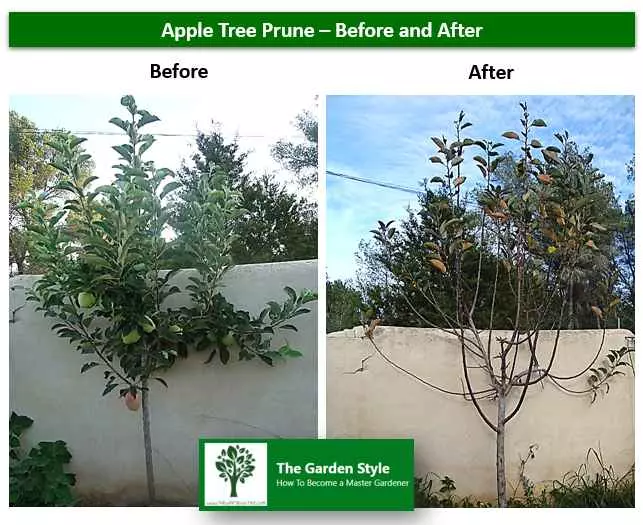
Let’s see this Prune Apple Tree Diagram
When and How to Prune A Free-Growing Apple Tree
The first pruning of our apple trees should be done at planting. Between November and March, if the apple tree has three main branches (one-year-old branches), these are cut back 10-12 inches (25-30 cm) with good pruning shears. They are pruned at the same level and on an outward-facing bud.
If the apple tree is more developed (two years old), the six high branches are cut back 10-12 inches (25-30 cm), and the lower branches are pruned above the second bud from the base.
If a bare-root specimen is acquired, the tips should be cut back a few centimeters.
From the fifth year after planting, between November and February, prune to reduce the size of the crown by about one-third to keep the apple production close to the center of the tree. Forked branches, crossing branches, poorly positioned branches (towards the center of the tree), and suckers are removed.
The main forms of apple tree pruning and their uses
Free-Growing Tree
It does not need any support to support its branches. It has a more or less tall trunk. This form of pruning is ideal for the cultivation of vigorous varieties such as Melrose, Belle de Boskoop, or Grey Reineta from Canada.
A cup or dome with a short trunk is also a free-growing form but grafted on a low-vigor rootstock. It will require regular fruiting pruning, unlike other free-growing forms. It is then referred to as a directed free-growing form.
Horizontal Cordon Pruning with One or Two Branches
The vertical stem of the apple tree bends at a right angle of 15-30 inches (40 to 80 cm) from the ground. If there are two stems, they are bent in diametrically opposite directions, forming a T-shape. The cordon is well adapted to varieties of medium to weak vigors, such as Bella de Boskoop (Schone van Boskoop), Granny Smith Apples, Fuji Apples, Reineta Apples, Reineta de Mans or Royal Gala.
Pruning Apple Trees in The Shape of a Small Palmette
The simple U-palmette is the most common. This shape is suitable for varieties of medium to weak vigors such as Reineta, Reineta de Mans, or Royal Gala. The tree is composed of two master branches of identical size.
Pruning the Large U-Shaped Apple Tree
The large U-shaped or double palmette is made up of two short main branches that divide in two at the base. It is composed of four main branches of equal strength. It is recommended for varieties of weak or medium vigor.
Pruning the Apple Tree in Verrier Palmette
Likewise, it has four equal-sized main branches, which are framed by each other. It is recommended for varieties of weak to medium vigor.
Does the Moon Influence Pruning?
As a general rule, it is recommended to prune in the waning phase of the moon when the tree’s sap is more “stationary”. But from my own experience, I would say that it is not an essential issue when pruning.
We will have much more in mind regarding the weather forecast for the 3-4 days following the pruning. We will avoid doing it if there is a risk of big frosts or a lot of rain, because if so, there is more probability of rotting or diseases through the cut.
Care for Apple Trees After Pruning
When to Fertilize Apple Trees
On nutrient-rich soils, you can withhold fertilizer use until your apple trees begin to set fruit (average: 2-4 years). If your new apple trees do not produce an average of 8 to 12 inches of fresh green growth during the growing season, try feeding them in the spring after their installation.
Typically, fertilizers are used during the growing season as soon as the soil is ready to work in early spring and stop on July 1. For specific fertilizer application instructions, always refer to the information printed on your product label. Please note that local fertilizer recommendations may be in effect at different times of the year. For the sake of your local environment, please respect these restrictions.
After your apple trees begin to bear fruit, their nitrogen uptake increases. In response to this, a high nitrogen fertilizer application is recommended once in early spring for fruiting apple trees. An example of a nitrogen fertilizer is our Stark® orchard granular fertilizers.
To prevent the possibility of injury as the growing season approaches, do not fertilize after July 1.
We hope you find useful this article about the Prune Apple Tree Diagrams and the VIDEO On How to Prune Apple Trees have tons of success, and apples on your next crop. Learn more about when to harvest Granny Smith apples.
Learn more about Pruning:
- Prune Gardenia Plants (Gardenia jasminoides): How to Prune Gardenias and When to Prune Gardenias
- How to Prune Hydrangeas – Guide
- Root Pruning: When and How to Prune the Roots
- How to Prune Peach Trees and When to Prune Peach Trees
- How to Prune Crepe Myrtle and When To Prune Crepe Myrtle Trees
- How to Prune Orange Tree Step by Step – Guide
- How to Prune Raspberries – Ultimate Guide
- How to Prune Fig Tree – Step by Step – Guide
- How to Prune Rose of Sharon – Step by Step
- How to Prune Orchids – Step by Step Guide
- How to Prune a Pear Tree & Increase Pear Production
- How to Prune Meyer Lemon Tree – Ultimate Guide
- How to Prune Basil – Different Methods (With Pictures)
- Prune Tomato Plants: How to Prune Tomato Plants for Maximum Yield & When
- How to Prune Bonsai – Ultimate Guide
- How to Prune Ficus Tree – Step by Step
